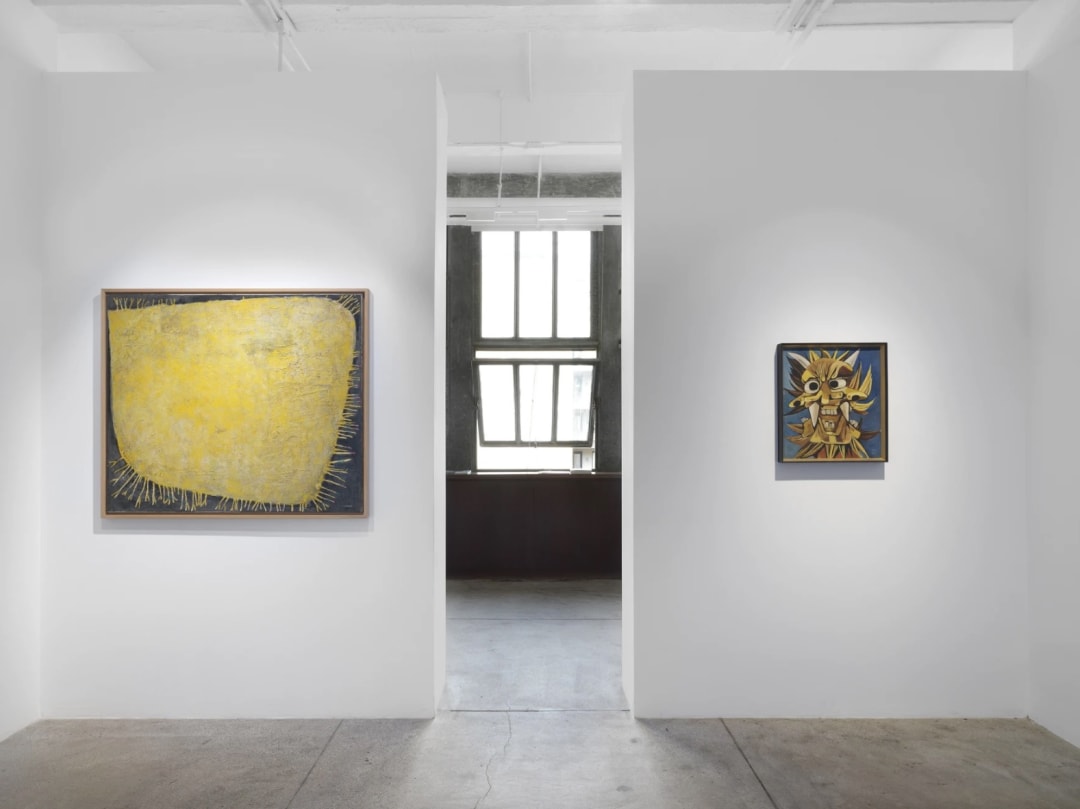Yuki Katsura (b. Tokyo, 1913-1991) resisted dominant aesthetic traditions throughout her six-decade career, constantly interrogating materiality, spatial depth, and representation in her works. Often unrecognized in western art circles, Katsura has long been established as an artist of critical acclaim in Japan—a pioneering force amongst a very male-dominated society. She took the Tokyo painting world by storm in the pre-war years and rose to prominence in the post-war, becoming a central figure in the genesis of the Japanese avant-garde. Her prolific oeuvre is highly unusual as it attests to a brave and remarkable continuity of expression.
Born into a upper-middle class family of samurai lineage in Tokyo, Katsura studied Japanese-style painting (nihonga) under renowned ink painter Ikegami Shūho, and western style oil painting (yōga) from painters Kenichi Nakamura and Saburōsuke Okada. She was introduced to European abstraction while studying at the Avant-Garde Yōga Research Institute (Abangyarudo Yōga Kenkyūjo) under the radical Tsuguharu Fujita and Seiji Tōgō. In the years leading up to the war, Katsura experimented extensively with non-art materials such as cork, rope, and kasuri (splash pattern) fabric, creating inventive collage and assemblage works that earned her acclaim in art circles as a distinctly female modernist with a critical spirit. She held her first two solo exhibitions in Tokyo and participated in annual exhibitions organized by the Nika-kai from 1935-1943. In 1938, she and influential Gutai artist Jirō Yoshihara founded the Ninth Room Association (Kyushitsu-kai), an avant-garde subgroup of Nika-kai. In the immediate post-war, Katsura’s work took a more political turn—she employed satirical caricature and folkloric allegory to address the tumultuous political landscape surrounding women’s rights and nuclear power. She co-founded the Association of Women Painters (Jyoryū Gaka Kyōkai) in 1946 with Setsuko Migishi, was invited byrenowned painter and theorist Taro Okamoto to participate in his literary-artistic group, Night Art Society (Yoru no Kai) in 1948, and created illustrations for cultural critic Kiyoteru Hanada. In 1947, she also became an organizing secretary of the short-lived Japan Avant-Garde Artists Club (Nihon Abangyarudo Bijutsuka Kurabu), which contributed to the regrouping of significant artists after the war. Katsura served as an important member and juror of the Nika-kai from 1950-56.
Katsura left Japan in 1956, spending two years exploring and exhibiting in Europe with Paris as her base. She then spent three months living in the village of Bambari in Central Africa before moving to New York City, where the artist set up her studio and furthered her experimentation with abstraction and texture for almost three years. She was active amongst various circles of the western avant-garde, socializing with Yves Klein, Michel Tapié, Jean Cocteau, Sam Francis, Mark Tobey, Franz Kline, and Louis Nevelson. She frequented the highly artistic and notable circle around Betty Parsons, one of New York’s most influential art dealers of the time. Katsura was also in contact with Yayoi Kusama; in 1960, the two prolific female painters were included in a seminal group exhibition of six abstract Japanese painters at Gres Gallery in Washington D.C., alongside Minoru Kawabata, Kenzō Okada, Toshinobu Onosato, and Takeo Yamaguchi. She returned to Japan in 1961, where she published four autobiographical memoirs and continued stylistic experimentations until her death in 1991. Katsura’s diverse body of work reflects her active pursuit of materiality and fiercely independent approach to modernist expression in the 20th century.
Katsura has been the subject of solo exhibitions at Tokyo Gallery, Tokyo (1961, 1979, 1989, 2015); Gallery Garando, Nagoya (1980); Ina Gallery, Tokyo (1985); Taka Ishii Gallery, New York (2018); Yamaguchi Prefectural Museum of Art (1980); Shimonoseki Municipal Museum of Art (1991); Ibaraki Prefectural Museum of Modern Art (1998); Ichinomiya City Memorial Art Museum of Setsuko Migishi (2007); the Museum of Contemporary Art, Tokyo (MOT) (2013); and the Shimonoseki City Art Museum (2013). Her work has also been included in significant international group exhibitions, such as the International Female Artists Exhibition, Musee d'Art Moderne, Paris (1957); Micro-Salon Exhibition, Iris Clert Gallery, Paris (1957); International Contemporary Painting, University of Arizona Art Gallery, Tucson, AZ (1959); 11th PREMIO LISSONE International Art Exhibition, Lissone, Italy (1959); Abstract Japanese Art, Gres Gallery, Washington, D.C. (1960); Twenty-seventh Corcoran Biennial, Washington, D.C. (1961); Carnegie International Exhibition, Pittsburgh, PA (1961); Resounding Spirit: Japanese Contemporary Art of the 60s, The Gibson Gallery Collection, New York (2004).
The artist’s work is included in the collections of the Museum of Modern Art, Kamakura & Hayama; Ohara Museum of Art; Itabashi Art Museum; the Museum of Contemporary Art Tokyo; the Yokohama Museum of Art; and the University of Arizona Museum of Art.
